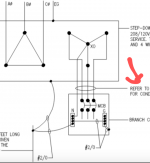The transformer and secondary panelboard are inside in electrical shed. Below is complete picture of schematic
View attachment 2565692
Thank you for the reply.
I was wondering if the note,
'Refer to transformer scheldule for conduit and wire sizes" would help shed more light on the install.
My take on it is. An SSBJ
Should be installed and the conductor from transformer case to electrode should be removed.
An SSBJ would be required unless it has metal conduit continues between the two with proper bonding.
If the schedule in the note called for PVC for some reason. Than a wire type SSBJ is required.
The primary EGC and the SSBJ shall land in the same bar inside the transformer.
Another item I was thinking about was a primary disc in or on the separate structure since it is fed with a feeder.
I was going to do more read on this. Since this is a new structure where is the uffer.
I would think the whole grounding detail
would need to be reworked if a primary disc is required. I think it is.
Others may chime in on that one. I know that was not your question I was just thinking it through based on where the install is located.
Again thank you for sharing the information.
Tulsa



